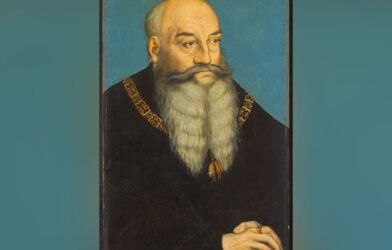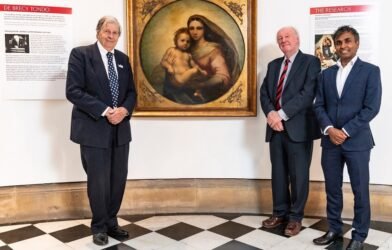 The Water Swan, 2024. Photographs: courtesy of Thyssen-Bornemisza Museum (Madrid)
The Water Swan, 2024. Photographs: courtesy of Thyssen-Bornemisza Museum (Madrid)
By LAURA DE REMEDIOS July 19, 2024
Having your work displayed just two rooms away from the pieces that inspired your journey as a painter is no small matter. With Goya and Van Gogh as neighbours, Robert Nava has made the Thyssen into a temporary home for some of his artwork. Through his gallery PACE, the American artist is exhibiting in the Thyssen Museum of Madrid until September 22nd, as part of the museum’s efforts to support contemporary art. Most of the paintings have never been shown before, leaving a unique setup for his artwork reminiscent of the Bad Painting movement, a movement which embraces ‘bad taste’ and subverts traditional aesthetic standards.
Yet in response to a remark concerning the supposedly incomplete appearance of his works, Nava chuckled and provided an insightful remark: “I think they’re all finished,” he began. “Some of my friends, who are fans of abstract art, will ask, ‘If you could add one more mark, what would it be?’ And you can’t. It’s done. You could, but then you’d mess it up. You might find the answer in another 20 steps. Is the best painting at step 7, 47, or 307?”.
Nava’s take on knowing when to stop painting is all about striking that perfect balance. While he doesn’t obsess over each stage as he paints, he has a knack for spotting when he’s gone a bit too far. “After the painting is done, if I’ve overworked it, I can see where I messed up,” he confessed with a laugh.
And while, indeed, a difficult balance to strike, he approaches this difficulty with humour. Imagine Nava, a seasoned artist, watching another painter’s sped-up process, cringing as the artist goes from a masterpiece at minute two to a mess by minute ten. It’s a mix of comedy and tragedy, illustrating just how easy it is to overdo it. Nava’s point is clear: the best creations come from knowing when to stop. It’s about declaring something done, even when the urge to add more is strong. This lesson extends beyond art—sometimes, good enough is truly good enough.
 Greasefang Dog, 2023
Greasefang Dog, 2023
In an age of instant gratification, Nava’s insights emphasise the challenge of recognizing when a piece is finished. Reflecting on changing audience engagement, he noted, “I remember watching a 12-minute YouTube video about my work. A few years ago, that wasn’t too long. Then it shrank to five minutes, and even that was too lengthy. Now, it’s a seven-second reel.” Despite this shift, Nava remains unhurried in his artistic journey. Working in his current style for about seven years, he feels he’s just begun. His approach is intuitive, changing only when it feels natural. “Artists might take their time, maybe a lifetime, on one idea,” he explained, highlighting his commitment to patience in a world that values brevity.
He’d been one of those kids as a child who could draw anything with a pencil and sheet of paper. “In middle school, if you wanted an image of anything, you brought it to us, and we’d draw it for you”. But it wasn’t until his undergraduate art programme that Nava reframed his conception of creative worth and technique. When thinking back on a photorealistic drawing assignment he and his classmates had to complete, he noticed: “the ones that were ‘screwing it up’ were some of the best paintings for me. They were way more interesting than if you were to ace this project and did it perfectly. It was so much cooler in this other, deconstructed way, sort of the reverse to the traditional, academic way.”
 Battle of Olympus, 2023
Battle of Olympus, 2023
Rules – do we need them?
As Nava progressed through his education, he absorbed the classical techniques and principles of Renaissance art, gaining a deep appreciation for the discipline it demanded. “You learn the standards and you respect them,” he reflected. “And then you get to advanced painting, and it’s like, ‘Everything we just taught you doesn’t matter. Here are some examples of contemporary art.'”
Nava’s work blurs the lines between following and ignoring rules. “I don’t know if you need the rules,” he mused. “Having them and then breaking them versus not having them at all and just going for it. I value some rules like composition and balance; they unconsciously make a picture.”
Nava’s educational journey, oscillating between traditional mastery and contemporary deconstruction, prompted him to question his own artistic motivations. This reflects a broader conversation in the art world, where the tension between classical standards and modern innovation continues to challenge and inspire artists. In this manner, Nava’s trajectory, like many of those endeavouring into contemporary art, underscores the importance of questioning norms and finding a personal voice amidst evolving artistic paradigms.
What about titles?
When asked why the exhibition does not have a title, he laughed. “I think it just never came up. Not saying I wouldn’t have done one, but titles are sometimes the hardest things for me.”
“Titles will definitely start to suggest a meaning to the paintings. People will start thinking of it ‘cause our minds can’t help it. If I titled the show ‘Grandma’ or something it would immediately change how you view the work,” he burst out laughing. I then imagined what exactly I’d think of his paintings if the show was called Grandma: was his cat, Jumanji, his grandmother reincarnated? Was she also within the Volcanic Angel? Was it an ode to the many forms she took in his life? “We’re so funny as creatures” he continued, chuckling “‘Cause there’s nothing else to give, so your mind naturally wants to give it meaning, it tries to and will do it unconsciously”. Nava doesn’t take his work too seriously, just enough. It striked me how in peace he was with a titleless exhibition, testament to the autonomy and dignity of each painting as its own entity.
 Volcanic angel, 2020
Volcanic angel, 2020
Present and future – but mostly present
And what are Nava’s inspirations? His muses? Walking around the show, it won’t take one long to guess his aforementioned cat, Jumanji. “For a lot of years he was right there. I worked in my living room for a good eight years and he was there for about six of those. So he knows, he’s just always been around.” And I wondered how none of his paintings depicted people, to which, in his unhurried, patient fashion, he replied: “I might start painting people, I just really haven’t gotten to it yet, so far. Not to totally exclude them, just so far it hasn’t really happened”. The pressure of expediency is not one to faze Nava, rendering his work all the more valuable, as they are the result of patience and prudence.
 Jumanji Learns Fire, 2019
Jumanji Learns Fire, 2019
Nava’s unhurried approach extends beyond his painting. While in Madrid to prepare for the exhibition, he did not limit the experience to a work trip – and savoured all Spain’s capital had to offer. The highlight of his visit? Attending the Real Madrid semi-final against Bayern Munich at the Bernabeú. Reflecting on his travels in Europe, Nava particularly enjoyed how Europeans often remarked on his resemblance to Maradona, a comparison he embraced humorously by claiming to be Maradona’s son. When asked if this experience made him a Real Madrid fan, he laughed, preferring to stay neutral to avoid stirring any rivalries.
While Nava may not have declared allegiance to Real Madrid, the city is undoubtedly a fan of his, and a very special one until September 22nd. WM









